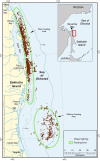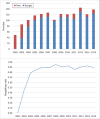Site-fidelity and spatial movements of western North Pacific gray whales on their summer range off Sakhalin, Russia
- PMID: 32797058
- PMCID: PMC7428188
- DOI: 10.1371/journal.pone.0236649
Site-fidelity and spatial movements of western North Pacific gray whales on their summer range off Sakhalin, Russia
Abstract
The Western North-Pacific (WNP) gray whale feeding grounds are off the northeastern coast of Sakhalin Island, Russia and is comprised of a nearshore and offshore component that can be distinguished by both depth and location. Spatial movements of gray whales within their foraging grounds were examined based on 13 years of opportunistic vessel and shore-based photo-identification surveys. Site fidelity was assessed by examining annual return and resighting rates. Lagged Identification Rates (LIR) analyses were conducted to estimate the residency and transitional movement patterns within the two components of their feeding grounds. In total 243 individuals were identified from 2002-2014, among these were 94 calves. The annual return rate over the period 2002-2014 was 72%, excluding 35 calves only seen one year. Approximately 20% of the individuals identified from 2002-2010 were seen every year after their initial sighting (including eight individuals that returned for 13 consecutive years). The majority (239) of the WNP whales were observed in the nearshore area while only half (122) were found in the deeper offshore area. Within a foraging season, there was a significantly higher probability of gray whales moving from the nearshore to the offshore area. No mother-calf pairs, calves or yearlings were observed in the offshore area, which was increasingly used by mature animals. The annual return rates, and population growth rates that are primarily a result of calf production with little evidence of immigration, suggest that this population is demographically self-contained and that both the nearshore and offshore Sakhalin feeding grounds are critically important areas for their summer annual foraging activities. The nearshore habitat is also important for mother-calf pairs, younger individuals, and recently weaned calves. Nearshore feeding could also be energetically less costly compared to foraging in the deeper offshore habitat and provide more protection from predators, such as killer whales.
Conflict of interest statement
First author Koen C.A. Bröker was employed by Sakhalin Energy Investment Company Ltd. from 2006 –2010 and by Sakhalin Energy Investment Company Ltd.’s shareholder Shell from 2010 onwards. Jennifer M. Dupont was employed by Exxon Neftegas Ltd.’s shareholder ExxonMobil from 2010 onwards. This does not alter our adherence to PLOS ONE policies on sharing data and materials.
Figures






References
-
- Henderson D. Nineteenth century gray whaling: grounds, catches and kills, practices and depletion of the whale population In: Jones M, Swartz S, Leatherwood S, editors. The gray whale, Eschrichtius robustus. Orlando, FL: Academic Press; 1984. p. 159−86.
-
- Weller D, Burdin A, Würsig B, Taylor B, Brownell R. The western Pacific gray whale: a review of past exploitation, current status and potential threats. J Cetacean Res Manage. 2002;4:7−12.
-
- Reeves R, Smith T, Lund J, Lebo S, Josephson E. Nineteenth-century Ship-based Catches of Gray Whales, Eschrichtius robustus, in the Eastern North Pacific. Mar Fish Rev. 2010;72(1):26–65.
-
- Bowen SL. Probable Extinction of the Korean Stock of the Gray Whale (Eschrichtius robustus). J Mammal. 1974;55(1):208–9.
-
- Berzin A. Practical Problems in the study of whales (using the example of Pacific whales). Vertebr Zool 1974;6:159–89.
Publication types
MeSH terms
LinkOut - more resources
Full Text Sources

